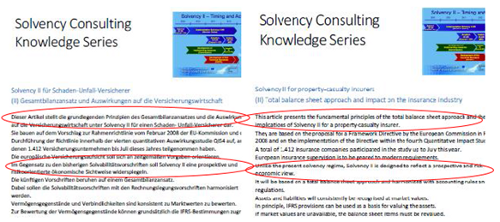The Dictionary Builder creates dictionaries from bilingual texts.
Dictionary Builder creates new dictionary entries form bilingual texts. It makes use of the feature AutoLearn<word> which is available in the Lingenio product translate 12.1 pro; it integrates this feature together with the Lingenio sentence aligner and extends coverage to bilingual texts instead of translation memories alone (as available in the current version of translate pro) and adapts the functioning of extraction and preparation of data to the needs of the customer.
The output is available in the format of translate user dictionaries and can be connected to the translate systems and the Lingenio translation server as additional lexical resource. The output is available in an XML-formatted version also, in order to be used stand-alone or via integration into other translation tools and CAT-systems.
In the following we illustrate the workflow using an example from bilingual texts about the new European solvency legislation as provided by the insurer Munich Re on the internet:


Fig. 1 shows parts of German and English versions of the text where two alignment results as computed by Lingenio sentence aligner are highlighted.
On the basis of such sentence pairs AutoLearn<word> searches for new translation relations, extracts corresponding suggestions and, if accepted by the user, builds new dictionary entries from these. Fig. 2 shows the suggestions found by AutoLearn<word> for the first sentence highlighted in Fig. 1 (left side) and the dictionary entries built from these (right side).
The entries relate to lemmas of single words or multiword expressions of any category and assign morpho-syntactic and semantic classifications to the entries as can be derived from system knowledge and context.
The suggestions for new dictionary entries are presented clearly arranged (Fig. 2), following the order of sentences searched. After adoption of single or all suggestions the entries can be edited and manually corrected and extended, if seems necessary.
In this manner, the system can be fed with new knowledge from texts continuously and is adapted to the specificity of the customer texts the more it learns.
Make sure to also watch our tutorial on AutoLearn<word>.
![]() In addition to Lingenio’s translate netzwerk, the insurance company uses a detailed technical dictionary about the new European solvency law regulations Solvency II compiled and checked by Lingenio.
In addition to Lingenio’s translate netzwerk, the insurance company uses a detailed technical dictionary about the new European solvency law regulations Solvency II compiled and checked by Lingenio.
Please contact us for further information, prices and individual advice by sending us an e-mail.
